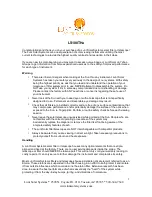
position. This adjustment will rarely, if ever need to be done.
If the entire primary mirror reflection is not visible in the sec-
ondary mirror, as in Figure 6c, you will need to adjust the tilt of
the secondary mirror. This is done by alternately loosening
one of the three alignment screws while tightening the other
two, as depicted in Figure 8. The goal is to center the primary
mirror reflection in the secondary mirror, as in Figure 6d. Don’t
worry that the reflection of the secondary mirror (the smallest
circle, with the collimation cap “dot” in the center) is off-center.
You will fix that in the next step.
Adjusting the Primary Mirror
The final adjustment is made to the primary mirror. It will need
adjustment if, as in Figure 6d, the secondary mirror is cen-
tered under the focuser and the reflection of the primary
mirror is centered in the secondary mirror, but the small reflec-
tion of the secondary mirror (with the “dot” of the collimation
cap) is off-center.
The tilt of the primary mirror is adjusted using the three sets
of two collimation screws on the back end of the optical tube.
Adjusting the tilt of the mirror requires a “push-pull” technique
involving adjustment of each set of collimation screws. Loosen
one of the screws a full turn, and then tighten the adjacent
screw until it is tight (Figure 9) (do not overtighten). Look into
the focuser and see if the secondary mirror reflection has
moved closer to the center of the primary.You can tell this eas-
ily with the collimation cap and mirror center mark by simply
watching to see if the “dot” of the collimation cap is moving
closer or farther away from the ring on the center of the pri-
mary mirror. Repeat this process on the other two sets of
collimation screws, if necessary. It will take a little trial and
error to get a feel for how to tilt the mirror in this way. When
you have the dot centered as much as possible in the ring,
your primary mirror is collimated. The view through the colli-
mation cap should resemble Figure 6e. Make sure all the
collimation screws are tight (but do not overtighten), to secure
the mirror tilt.
A simple star test will tell you whether the optics are accu-
rately collimated.
Star-Testing the Telescope
When it is dark, point the telescope at a bright star and accu-
rately center it in the eyepiece’s field of view. Slowly de-focus
the image with the focusing knob. If the telescope is correctly
collimated, the expanding disk should be a perfect circle
10
Figure 7. To center the secondary mirror under
the focuser, hold the secondary in place with
your fingers while adjusting the primary screw
with a Phillips head screwdriver. Do not touch
the mirror’s surface.
Figure 8. Adjust the tilt of the secondary mirror
by loosening or tightening the three alignment
screws with a small Phillips head screwdriver.
Figure 9. Loosen one screw on the back of the
optical tube one full turn and tighten the other
screw “in the set” until tight to adjust the pri-
mary mirror.





















